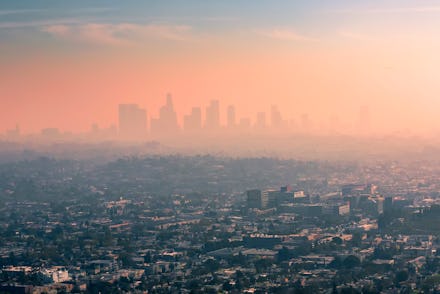Higher air pollution is linked to more coronavirus deaths, new research shows

As Americans are being told to brace for even more COVID-19 deaths, researchers are trying to figure out where people are at high risk so officials and healthcare workers can focus their attention on them. A new study published this week in the New England Journal of Medicine suggests a link between high levels of air pollution and the severity of coronavirus symptoms. It appears that people who live in areas with the dirtiest air have a higher coronavirus mortality rate than those in parts of the country with cleaner air.
The study, which was conducted at Harvard’s T.H. Chan School of Public Health, analyzed air quality data from over 3,000 counties in the US for the past 17 years and compared it with current COVID-19 severity and mortality rates. People who live in areas with high levels of particulate matter, known more formally as PM 2.5, were about 15% more likely to die of COVID-19, the study found. One theory about this finding is that living in areas with high air pollution over a prolonged period of time changes peoples’ bodies in ways that leave them more susceptible to the virus.
“We know that PM2.5 exposure causes or is associated with many of the pre-existing conditions that increase the severity of COVID-19,” says Rachel Nethery, one of the authors of the study and an associate professor of biostatistics at the T.H. Chan School of Public Health at Harvard. Her team’s research did not examine specific health conditions, but folks with asthma, for example — which research suggests is triggered and exacerbated by air pollution — seem to be at higher risk for COVID, according to the CDC. Nethery says that the health conditions associated with living areas with more air pollution are likely to explain at least part of the relationship between pollution and COVID-19 severity, but it may not explain all of it.
The study’s link between regions with high pollution levels and a higher risk of mortality offer insight into which areas are likely to need more resources if they are hit by the virus, Nethery tells Mic. While she did not specify which resources exactly, we can assume this includes ventilators and hospital beds for patients, and more personal protective gear for healthcare workers.
This information could be pivotal for hospitals in underserved neighborhoods with high populations of people of color, which are often in areas with higher pollution rates than hospitals in wealthy white areas, reported the New York Times. To be clear, these findings cannot predict which places will have COVID-19 outbreaks, but they can help health officials understand where the most vulnerable people are and educate them about how severely they could be affected by an outbreak. “This information can help us prepare by encouraging these populations to take extra precautions,” says Nethery.
Unfortunately, there are no quick fixes to either air pollution or the novel coronavirus. “This study was looking at the relationship between COVID-19 mortality rates and exposures accumulated over the past 20 years,” she explains. But the research gives us a broader perspective on how we can start to think more holistically about the compound problems of the COVID-19 pandemic and pollution. “It is likely that COVID-19 will be a part of our lives for quite a long time, despite our hope that a vaccine or treatment is developed quickly,” Nethery says. “In light of this, we should consider additional measures to protect ourselves from pollution exposure to reduce the COVID-19 death toll in the long term.”